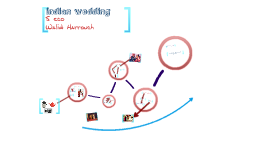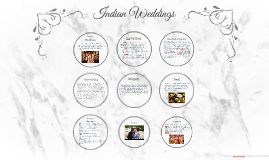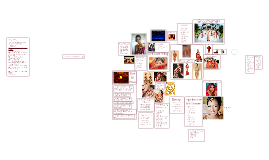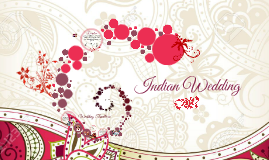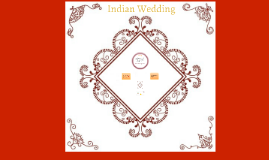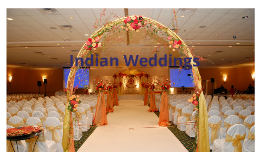Indian Wedding
Transcript: Clothing Weddings are a big part of Indian and Hindu culture. Indian weddings are usually arranged and involve different traditions and ceremonies. Decoration, food, and religion are some of the most important parts of the wedding. Arranged Marriage Indian Weddings Most Indian weddings are comprised of three parts: the pre-wedding festivities, the marriage ceremony, and post- wedding. There are many fun and interesting rituals associated with the pre-wedding. Some of these are: The Haldi ceremony- A holy ceremony where a paste of turmeric, oil and water is applied to the bodies of the bride and groom. This is said to both promote healthy skin and keep the evil eye away. The Mehndi ceremony- For the bride and her female relatives and friends only, Henna is applied to the bride's hands. It is said that the darker the color of the dried henna, the stronger the love of the groom for his bride. Traditional brides' clothing includes either a sari or a lahenga, both decorated in ornate embroidery. Colors that are considered lucky are red, white, green, and yellow. Brides usually wear red, which represents prosperity and fertility. The groom wears a dhoti or a sherwani, in white, off-white, or beige. It is also embroidered. https://oiss.rice.edu/WorkArea/DownloadAsset.aspx?id=854 Religion Food Post- wedding After the wedding, the bride bids farewell to her family as she leaves for her husband's house. This is a very emotional experience for the bride and her family members. In some cultures, the bride is carried from the wedding in a doli. This conveys her good wishes to her parents. Upon arrival at the home of the groom, they must engage in several rituals to ensure good luck in their marriage. At the door, the bride must topple a metal pot with her foot. The first step the newlyweds take in their new home must be with their right feet. The bride and groom also perform a prayer, to show their gratitude to the lord. Married couples often throw a reception at their new home for their family and friends. https://oiss.rice.edu/WorkArea/DownloadAsset.aspx?id=854 Indian weddings are typically held at either the home of the bride or a wedding hall. The arrival of the groom to the house of his bride is a very important event. The groom leaves home on a decorated horse, or, for the more extravagant, an elephant. He is accompanied by a large procession of his family and friends. At the wedding hall, after the bride and groom exchange decorative garlands, they engage in a variety of rituals including the Kanyadaan, or giving away of the bride by the father. The couple is considered wed when the groom ties a thali, which is a sacred thread. The entire wedding is done around a sacred fire and after the bride and groom encircle the fire seven times. This is called Saat Phere and it symbolizes the couples seven goals of marriage. The ceremony culminates with the groom applying vermillion to the forehead of his bride, welcoming her as his partner for life. http://www.culturalindia.net/weddings/wedding-preparations/wedding-food.html Throughout and leading up to the wedding, many prayers are made by the bride and groom, especially on the day of the wedding. These include prayers to gods including the Indian goddess Parvati and Ganesha, the deity of overcoming obstacles. The majority of the wedding is done around a sacred fire for the purpose of having the fire god Agni as the main witness of the marriage. In Western societies, physical attraction often plays a big part in who we decide to go out with initially. But arranged marriages, which are in part based on the assumption that young people will just seek pleasure instead of looking at the big picture, are much more analytical. The major factors that must be taken into account are: Reputation- of the family. Vocation- the more prestigious, the better. Wealth Appearance- height and color are the main traits to consider. Values- traditional/liberal. Caste/Religion Horoscope- must be compatible (this was traditionally true). Medical- Hereditary disease is becoming an increasingly important factor. Indian Weddings Pre-wedding Wedding Image by goodtextures: http://fav.me/d2he3r8 Sources Food is served after the wedding ceremony. The food is traditional and typically vegetarian. Indian cuisine is very diverse and flavorful, and some say the wedding would be incomplete without such food. Wedding ceremony







